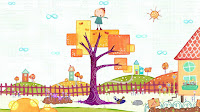During this crazy time, many of my families have reached out to me for tips on keeping their kids stimulated and their brains working. Over the years, I have found that there are some amazing apps out there that motivate our kids and I am going to share some of my favorites. Many of these have been on lists I have compiled in the past but many are new. I have also included some mindfulness and movement apps because while we are spending a lot more time inside right now, moving around and keeping active is critical to a child’s ability to learn.
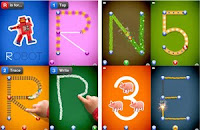 LetterSchool-not sure when I started using this handwriting app, but it is used multiple times per week. When I first discovered this app, it focused on learning upper and lowercase letters and numbers. In the past few years, they have added many other learning components such as shapes/pictures, cursive, sight words and more. I love how motivating and engaging this app is. Kids learn how to write letters through a 3-step process. As they finish each step, they get to watch the letter come to life in a really fun way.
LetterSchool-not sure when I started using this handwriting app, but it is used multiple times per week. When I first discovered this app, it focused on learning upper and lowercase letters and numbers. In the past few years, they have added many other learning components such as shapes/pictures, cursive, sight words and more. I love how motivating and engaging this app is. Kids learn how to write letters through a 3-step process. As they finish each step, they get to watch the letter come to life in a really fun way.
Tap-tap the dots and watch the lines come to life to create the letters. The letter won’t come to life unless you hit them at the right place and in the right order
Trace-now that you know where to start your letters, you will now trace/drag lines at the dots to form letters.
Write-this is a chance for your child to practice writing the letter they have practiced with fewer prompts. The chalkboard portion of this app is a great last step to learning how to write letters, numbers or shapes.
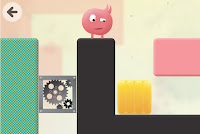 Avokiddo Thinkrolls-this is easily one of my favorite apps for the older children on my caseload and is great for working on developing executive functioning skills. At this point, there are several to choose from but I am partial to the original two and the most recent one, Space. I think it’s important to say as much as I love this app, kids ask to play it all the time. The purpose of the game is to move your chosen character/Thinkroll through a variety of obstacles in brightly patterned mazes. As they move through the chapters, they are introduced to new objects with unique physical properties that they have to problem solve in order to move through the maze. For example, there may a balloon in their way; by looking at the maze, they see they can move the balloon over so it goes up in the air and pops via spikes on the ceiling. Each of the apps provides something unique, but all help the children work on problem solving, organizational skills, sequencing all while teaching them about science. Here are links to all four of the Thinkrolls games:
Avokiddo Thinkrolls-this is easily one of my favorite apps for the older children on my caseload and is great for working on developing executive functioning skills. At this point, there are several to choose from but I am partial to the original two and the most recent one, Space. I think it’s important to say as much as I love this app, kids ask to play it all the time. The purpose of the game is to move your chosen character/Thinkroll through a variety of obstacles in brightly patterned mazes. As they move through the chapters, they are introduced to new objects with unique physical properties that they have to problem solve in order to move through the maze. For example, there may a balloon in their way; by looking at the maze, they see they can move the balloon over so it goes up in the air and pops via spikes on the ceiling. Each of the apps provides something unique, but all help the children work on problem solving, organizational skills, sequencing all while teaching them about science. Here are links to all four of the Thinkrolls games:
Thinkrolls
Thinkrolls 2
Thinkrolls Space
Thinkrolls: Kings and Queens
 Endless Learning Academy-another engaging, motivating, interactive and fun educational app that provides comprehensive early learning preparation for children between ages 2 and 6 years old. Through thousands of interactive learning activities, children will learn their letters and numbers, how to read, vocabulary, phonics, spelling, counting, sequences and so much more. I have been obsessed with the Endless Alphabet game for years and it is nice to have all of the games in one place. The kids on my caseload have learned how to identify letters, learn their sounds, practice matching letters and so much more with just the Endless Alphabet Game. This app from Originator is one of those apps that requires an annual subscription but I think it is totally worth it considering you can use it for so many kids at different levels of learning.
Endless Learning Academy-another engaging, motivating, interactive and fun educational app that provides comprehensive early learning preparation for children between ages 2 and 6 years old. Through thousands of interactive learning activities, children will learn their letters and numbers, how to read, vocabulary, phonics, spelling, counting, sequences and so much more. I have been obsessed with the Endless Alphabet game for years and it is nice to have all of the games in one place. The kids on my caseload have learned how to identify letters, learn their sounds, practice matching letters and so much more with just the Endless Alphabet Game. This app from Originator is one of those apps that requires an annual subscription but I think it is totally worth it considering you can use it for so many kids at different levels of learning.
 Math Tango-another great app from Originator that helps learning math interactive and fun! This app is targeted at children between the ages of 5 and 10 years old and focuses on learning addition, subtraction, multiplication and division. Kids will progress through dozens of math lessons as they earn monsters and robots, complete missions and build fun worlds. There are over 500 math games with over 40 levels of play. Once they conquer the structured levels, they have the option of practicing their math skills through free play mode.
Math Tango-another great app from Originator that helps learning math interactive and fun! This app is targeted at children between the ages of 5 and 10 years old and focuses on learning addition, subtraction, multiplication and division. Kids will progress through dozens of math lessons as they earn monsters and robots, complete missions and build fun worlds. There are over 500 math games with over 40 levels of play. Once they conquer the structured levels, they have the option of practicing their math skills through free play mode.
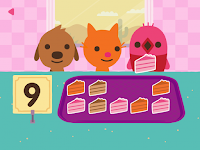 Sago Mini World-Sago Mini apps have been a long time favorite of mine to use with my littlest friends. This is definitely worth the subscription fee. There are 30 mini games for the kids to play that encourage open-ended play and critical thinking skills. Some of the skills that can be worked on with the mini games are color recognition, painting and storytelling skills, develop numeracy (counting, 1:1 correspondence, etc.), improve hand-eye coordination, visual motor and visual perceptual skills, encourage fine motor and manipulation skills and so much more.
Sago Mini World-Sago Mini apps have been a long time favorite of mine to use with my littlest friends. This is definitely worth the subscription fee. There are 30 mini games for the kids to play that encourage open-ended play and critical thinking skills. Some of the skills that can be worked on with the mini games are color recognition, painting and storytelling skills, develop numeracy (counting, 1:1 correspondence, etc.), improve hand-eye coordination, visual motor and visual perceptual skills, encourage fine motor and manipulation skills and so much more.
 Bugs and Buttons-this is an app that I have loved for years but wasn’t available for a while because of the operating system on my iPad. Little Bit Studio has recently updated the app and I am so excited to introduce this game to a whole new batch of kids. I love how engaging and interactive the 18 educational games are and how they were on a variety of developmental skills. Some of the developmental skills that can be worked on are improving fine motor and manipulation skills, improves hand-eye coordination, visual motor and visual perceptual skills, number and letter recognition and SO much more. Other games from Little Bit Studio are:
Bugs and Buttons-this is an app that I have loved for years but wasn’t available for a while because of the operating system on my iPad. Little Bit Studio has recently updated the app and I am so excited to introduce this game to a whole new batch of kids. I love how engaging and interactive the 18 educational games are and how they were on a variety of developmental skills. Some of the developmental skills that can be worked on are improving fine motor and manipulation skills, improves hand-eye coordination, visual motor and visual perceptual skills, number and letter recognition and SO much more. Other games from Little Bit Studio are:
Bugs and Bubbles
Bugs and Buttons 2
Bugs and Numbers
 Toca Boca Pet Doctor-this app is still one of the most requested by my kids at the gym after years and years on my iPad. Kids get to help take care of 15 different animals who are sick or injured. Once they are all taken care of, they get to feed them their favorite foods. The bunny rabbit has booboos and needs bandaids so kids have to find the matching bandaid for each booboo. The dog has fleas so you have to catch them and put them in a jar. This game is great for working on developing fine motor and grasping skills, improves visual motor and visual perceptual skills and works on improving focus, attention and other executive functioning skills.
Toca Boca Pet Doctor-this app is still one of the most requested by my kids at the gym after years and years on my iPad. Kids get to help take care of 15 different animals who are sick or injured. Once they are all taken care of, they get to feed them their favorite foods. The bunny rabbit has booboos and needs bandaids so kids have to find the matching bandaid for each booboo. The dog has fleas so you have to catch them and put them in a jar. This game is great for working on developing fine motor and grasping skills, improves visual motor and visual perceptual skills and works on improving focus, attention and other executive functioning skills.
 Little Fox Animal Doctor-another one of my favorite educational apps. And again, more importantly, a huge favorite with the kids that I work with. This game takes place in a magical doctor’s office in a treehouse in the woods and lets children help 7 different adorable animals dealing with over 20 different ailments and injuries. There are so many great things about this game but I really like how it is different each time because you never know why each of the animals is waiting to see the doctor. In addition to being great for working on improving fine motor, visual motor, visual perceptual and executive functioning skills, it also works on improving speech and language skills. Before you start to take care of each pet, you have to watch a short video which explains why they are at the doctors office. I use this an opportunity for kids to tell a story. The other great thing about this app is that there are visual instructions they have to follow so they work on improving organizational and sequencing skills at the same time.
Little Fox Animal Doctor-another one of my favorite educational apps. And again, more importantly, a huge favorite with the kids that I work with. This game takes place in a magical doctor’s office in a treehouse in the woods and lets children help 7 different adorable animals dealing with over 20 different ailments and injuries. There are so many great things about this game but I really like how it is different each time because you never know why each of the animals is waiting to see the doctor. In addition to being great for working on improving fine motor, visual motor, visual perceptual and executive functioning skills, it also works on improving speech and language skills. Before you start to take care of each pet, you have to watch a short video which explains why they are at the doctors office. I use this an opportunity for kids to tell a story. The other great thing about this app is that there are visual instructions they have to follow so they work on improving organizational and sequencing skills at the same time.
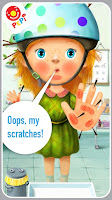 Pepi Doctor-this app by PepiPlay is another that has been on my must have app list since I discovered it years ago. In this app, kids get to play the doctor to three different patients (Amber, Eva and Milo). Each one of the kids has the same 5 ailments that need to be taken care of: a cold, a toothache, earache, broken bone and clean up cuts from a fall. Each ailment requires them to complete several tasks in order for their patients to feel better. Some of the tasks are putting the bone back together, brushing teeth, putting bandaids on scrapes and many, many more. This app is great for improving visual motor and perceptual skills, hand-eye coordination, focus, attention and organizational skills. It’s also a great app to work on improving language skills.
Pepi Doctor-this app by PepiPlay is another that has been on my must have app list since I discovered it years ago. In this app, kids get to play the doctor to three different patients (Amber, Eva and Milo). Each one of the kids has the same 5 ailments that need to be taken care of: a cold, a toothache, earache, broken bone and clean up cuts from a fall. Each ailment requires them to complete several tasks in order for their patients to feel better. Some of the tasks are putting the bone back together, brushing teeth, putting bandaids on scrapes and many, many more. This app is great for improving visual motor and perceptual skills, hand-eye coordination, focus, attention and organizational skills. It’s also a great app to work on improving language skills.
 Atomic Puzzles-puzzles are a huge part of my therapy sessions as they are great for working on so many different developmental skills. Our closet at Heads Up is filled with all kinds of puzzles but there isn’t enough room to store as many as we would like, especially the larger interlocking puzzles our older kids use. Atomic Puzzles from one of my favorite app creators, Little Bit Studios, not only comes with almost 100 puzzles (3D/Live puzzles that come to life once completed, 2D puzzles with animated endings and mystery puzzles) but offers you the chance to make your own puzzles from your collection of pictures which can be so motivating and exciting for kids. This is a great app for working on improving visual motor and perceptual skills, focus and attention, organizational skills and working through frustration tolerance.
Atomic Puzzles-puzzles are a huge part of my therapy sessions as they are great for working on so many different developmental skills. Our closet at Heads Up is filled with all kinds of puzzles but there isn’t enough room to store as many as we would like, especially the larger interlocking puzzles our older kids use. Atomic Puzzles from one of my favorite app creators, Little Bit Studios, not only comes with almost 100 puzzles (3D/Live puzzles that come to life once completed, 2D puzzles with animated endings and mystery puzzles) but offers you the chance to make your own puzzles from your collection of pictures which can be so motivating and exciting for kids. This is a great app for working on improving visual motor and perceptual skills, focus and attention, organizational skills and working through frustration tolerance.
 Toonia Differences-I love a good spot the differences game, especially for children who need to work on improving visual skills. Toonia Differences is a fun and motivating educational game where kids have to race the clock to spot the differences between two pictures. Kids have to visually track and focus carefully to noticed the 8 things that are different. It can be a flower is a different color, a character is facing a different direction or a change in the animals in pictures. There are dozens and dozens of puzzles to choose from with a variety of themes. In addition to working on improving visual skills, Toonia Differences works on improving executive functioning skills such as focus, attention, organizational skills and changing attentional skills.
Toonia Differences-I love a good spot the differences game, especially for children who need to work on improving visual skills. Toonia Differences is a fun and motivating educational game where kids have to race the clock to spot the differences between two pictures. Kids have to visually track and focus carefully to noticed the 8 things that are different. It can be a flower is a different color, a character is facing a different direction or a change in the animals in pictures. There are dozens and dozens of puzzles to choose from with a variety of themes. In addition to working on improving visual skills, Toonia Differences works on improving executive functioning skills such as focus, attention, organizational skills and changing attentional skills.
Peg+ Cat Tree Problem-another great app from PBS Kids based on the adorable cartoon, Peg + Cat. This math app is intended for kids 3-6 years old and teaches them early math and problem solving skills. There are 50 levels to play and 10 worlds for them to explore. The activities become more challenging as they move through the games. If you have kids who are eager to learn early math schools, this is a great game for them. Also, I think that kids are way more motivated to learn more challenging skills from some of their favorite characters.
 Trilo Spelling-when my daughter was finishing up kindergarten and preparing for first grade, I started to really panic about her reading skills. I knew developmentally she was where she was supposed to be but living in NYC, academic expectations are higher. I had spent a lot of time looking for the right app and each time I thought I had found it, she didn’t like it. So when we found this one, we were both thrilled! In Trilo Spelling, there are five levels of spelling and reading fundamentals with each level introducing kids to a different letter blends. Within each level, there are three different games/challenges they can play. The graphics and monsters within the app are fun and friendly, motivating children to want to learn how to spell. In addition to learning how to spell, children can work on improving executive functioning skills, hand eye coordination, visual motor and visual perceptual skills.
Trilo Spelling-when my daughter was finishing up kindergarten and preparing for first grade, I started to really panic about her reading skills. I knew developmentally she was where she was supposed to be but living in NYC, academic expectations are higher. I had spent a lot of time looking for the right app and each time I thought I had found it, she didn’t like it. So when we found this one, we were both thrilled! In Trilo Spelling, there are five levels of spelling and reading fundamentals with each level introducing kids to a different letter blends. Within each level, there are three different games/challenges they can play. The graphics and monsters within the app are fun and friendly, motivating children to want to learn how to spell. In addition to learning how to spell, children can work on improving executive functioning skills, hand eye coordination, visual motor and visual perceptual skills.
Dexteria Junior-this is a great app for working on developing fine motor and grasping skills with your little ones. What I love about this app is that the creators worked with occupational therapists to make it. Perfect for preschoolers and getting them ready for school. There are three different games:
Squish the Squash-encourages children to use their pointer finger to squish squashes. There are 15 levels for the kids to work through.
Pinch the Pepper-encourages children to use their thumb and pointer fingers to pinch the peppers. Great for developing a fine pincer grasp which is important for the developing proper pencil grips later on. There are 10 levels that become increasingly more challenging.
Trace and Erase-kids can learn how to draw various lines and shapes. They first trace the lines and then use an eraser after. Once they finish erasing the lines, they can take a silly selfie of themselves which my kids love. I have my kids use a stylus with this particular game to encourage proper grasp patterns when holding a writing instrument.
In addition to what I have already mentioned, this game is great for working on hand-eye coordination, visual tracking, focus, attention and planning and organizational skills.
Social Emotional/Mindfulness/Movement Apps
I think that we are all looking for tools to help our children get through this crazy time. Making sure our kids get opportunities for movement, mindfulness and social emotional learning on a daily basis will be very important, not only for them but for all the grownupsThere has never been a more critical time to spend time focusing on social emotional learning. Here are some great apps, some recommended to me by colleague, Dr. Chelsea Deng, from Milestones Psychology.
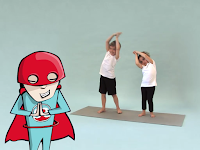 Super Stretch Yoga-I’ve used this one over the years and the kids really enjoy it and are able to follow along with it pretty independently. Move, play and breathe as Super Stretch introduces you to his friends and their yoga poses. Using storytelling, animation and video examples, kids move through 12 yoga poses and earn a star after each one. Yoga is a great way to help kids work on build overall body strength and motor planning, encourages healthy habits and is a quick and easy way to help them to be able to focus and attend to other tasks.
Super Stretch Yoga-I’ve used this one over the years and the kids really enjoy it and are able to follow along with it pretty independently. Move, play and breathe as Super Stretch introduces you to his friends and their yoga poses. Using storytelling, animation and video examples, kids move through 12 yoga poses and earn a star after each one. Yoga is a great way to help kids work on build overall body strength and motor planning, encourages healthy habits and is a quick and easy way to help them to be able to focus and attend to other tasks.
 GoNoodle Kids-this app is intended for classroom use and offers a tremendous resource of brain and body breaks during the school day. Now that your children will be working/learning from home and the amount of time we should spend outside is drastically limited, it’s important for not only them, but you as their grownups, to have these scheduled breaks. I highly encourage parents to engage in some of these movement activities as they are working from home.
GoNoodle Kids-this app is intended for classroom use and offers a tremendous resource of brain and body breaks during the school day. Now that your children will be working/learning from home and the amount of time we should spend outside is drastically limited, it’s important for not only them, but you as their grownups, to have these scheduled breaks. I highly encourage parents to engage in some of these movement activities as they are working from home.
 Daniel Tiger’s Grr-iffic Feelings-Daniel the Tiger is a big hit with many of my younger children and I have been a fan of the PBS Kids apps I have used in the past. Right now, kids are surely feeling a lot of feelings and emotions but may not be able to express that effectively and this app is perfect to help them. There are four games:
Daniel Tiger’s Grr-iffic Feelings-Daniel the Tiger is a big hit with many of my younger children and I have been a fan of the PBS Kids apps I have used in the past. Right now, kids are surely feeling a lot of feelings and emotions but may not be able to express that effectively and this app is perfect to help them. There are four games:
Trolley Game-drive the trolley to discovered more than a dozen mini-games about feelings
Sing-Along-choose from 18 of your favorite Daniel Tiger songs, each one fully animated
Drawing Easel-use paints, crayons, stickers and more to express yourself
Feelings Photo Booth-take pictures of yourself that show lots of different feelings. Daniel will help you pose!
Kids can work on developing fine motor, graphomotor, visual motor, visual perceptual and hand-eye coordination skills while learning all about feelings and emotions.
Breath, Think, Do With Sesame-this fabulous app from Sesame Street’s in Communities program is a great way to teach kids strategies on how to calm down, identify their feelings and work through their problem. Big feelings are totally normal but they can also makes kids feel scared. Kids will laugh and learn as they help a Sesame Street monster friend calm down through a variety of relatable situations: putting on shoes, saying goodbye to parents/caregivers, fixing a knocked down block tower, waiting in line or going to sleep. They play an active role in helping them choose what strategy would be best for the monster and then get to see the plan in action through a little video.
 Headspace for Kids-this subscription based app may be a really good investment, especially if your child is feeling overly anxious or worried right now. For professionals, the app is now free through the end of the year for anyone all public health providers! Headspace for Kids focuses on the following areas: Calm, Focus, Kindness, Sleep and Wake Up. For each area, there are three age groups to choose from (5 and under, 6-8 years and 9-12 years). Kids can practice breathing exercises, visualizations even try some focus-based mediation. Quirky cartoons engage kids while the calming voice of the co-founder of the app offers guidance throughout.
Headspace for Kids-this subscription based app may be a really good investment, especially if your child is feeling overly anxious or worried right now. For professionals, the app is now free through the end of the year for anyone all public health providers! Headspace for Kids focuses on the following areas: Calm, Focus, Kindness, Sleep and Wake Up. For each area, there are three age groups to choose from (5 and under, 6-8 years and 9-12 years). Kids can practice breathing exercises, visualizations even try some focus-based mediation. Quirky cartoons engage kids while the calming voice of the co-founder of the app offers guidance throughout.
Stop, Breathe, Think-here is another great app for younger children that works on self-regulation and teaches them about feelings and  emotions and appropriate mediation strategies to help them work through different situations. Kids pick a mission to find a guided mindfulness activity based on how they are feeling right now (they can choose up to three emojis to express how they are feeling). Missions are between two and seven minutes and made up of expressive narration, sometimes with quiet background music and simple animations. Missions demonstrated by different characters will lead you through mindful movements.
emotions and appropriate mediation strategies to help them work through different situations. Kids pick a mission to find a guided mindfulness activity based on how they are feeling right now (they can choose up to three emojis to express how they are feeling). Missions are between two and seven minutes and made up of expressive narration, sometimes with quiet background music and simple animations. Missions demonstrated by different characters will lead you through mindful movements.  Balloonamils-I’ve been using this app for a while with my younger kids, particularly when they have a whole lot of energy or when they might be feeling anxious. Kids blow into the microphone of the iPhone and watch a variety of balloon animals come to life. One the balloon is fully inflated (about 3 deep breathes), they shake the phone a couple of times and they watch the animal come to life. Once done, they can interact with the animal and see what kinds of tricks they can do. When they are done with that animal, they tap it a few times and he will pop. Not only great for helping kids to calm down but helps with hand-eye coordination, improves visual motor and visual perceptual skills and encourages grasping and manipulation skills.
Balloonamils-I’ve been using this app for a while with my younger kids, particularly when they have a whole lot of energy or when they might be feeling anxious. Kids blow into the microphone of the iPhone and watch a variety of balloon animals come to life. One the balloon is fully inflated (about 3 deep breathes), they shake the phone a couple of times and they watch the animal come to life. Once done, they can interact with the animal and see what kinds of tricks they can do. When they are done with that animal, they tap it a few times and he will pop. Not only great for helping kids to calm down but helps with hand-eye coordination, improves visual motor and visual perceptual skills and encourages grasping and manipulation skills.
iPad Use Tips
I know and understand that there are many parents who have been resistant in using iPads/screens for learning but if used the right way, it is an incredibly effective and motivating tool. Below, I share some tips when using an iPad.
JaqJaq Reusable and Erasable Paper-especially when doing handwriting or drawing apps, I always have kids practice with pen and paper immediately after practicing on the iPad. For example, when using LetterSchool, I have the kids practice the letter first and then have them write it again using “pen” and paper. In an effort to limit wasting of paper, I have recently begun using this amazing product. I like to use the ooly Dustless Chalk Crayons because they clean up quickly and easily and I have found that even my kids who have very weak hands have great success with these.
Cosmonaut Stylus-for a variety of reasons, kids spend more time on tablets these days. As with all things, as long as you don’t overdo it, working on the iPad can provide a lot of benefits. One of the things I recommend to all parents is that if they are going to let their kids use an iPad or other kind of tablet, be sure to have them use a stylus as much as possible to help develop fine motor and grasping skills. I think this is especially important if your child is doing any kind of handwriting or drawing apps. There are a lot of different stylus’ to choose from but the Cosmonaut is my favorite. It is a little pricier than some of the other ones made for children but it is far more durable. I have had mine for several years and it still looks brand new. The barrel of the stylus is thicker which encourages a tripod-like grasp when holding it.
Work Vertically-when possible, I have my kids use the iPad by propping it up so it is vertical (lean it against an easel). Working on a vertical surfaces is important for the following reasons:
-when you prop up the iPad on a vertical surface, it is in a better position and height which promotes visual attention
-improves hand-eye coordination
-encourages proper wrist positioning which helps with appropriate grasping on writing instruments
-strengthens shoulder, arm and and hand muscles
I have tried to include a variety of learning apps that will motivate your little ones and also tried really hard to choose ones that parents would have fun doing with their kids. This list is just a small sampling of the apps that I use so if parents are looking for certain apps, please do not hesitate reaching out to me. Also, I am always looking for new apps to use with the kids on my caseload so if you have any recommendations, please be sure to pass them along. I am always a click away and love hearing from all of you.

